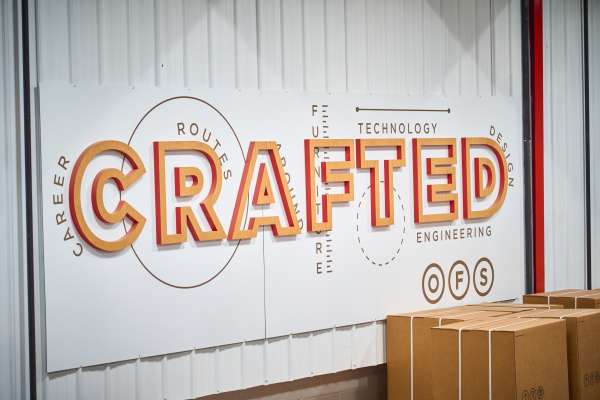A conversation with Dina Griffin
Recently, I had the opportunity to interview esteemed architect and friend, Dina Griffin. Dina is president of Interactive Design Architects (IDEA, for short), overseeing a growing firm of talented architects, engineers, and designers.
In this conversation, Dina and I discussed what inspired her to become an architect, the challenges she faced early on, and the advice she has for other young designers and architects just starting their careers.
We also spent time discussing one of her most notable and important projects, the Obama Presidential Center in Chicago. During our conversation, Dina shared what it was like to debut the plans for the project on stage with former President Obama in the same Chicago neighborhood where she grew up, a moment she says was one of the greatest honors of her life.
This was an inspiring conversation and Dina’s passion for the industry is infectious. She believes supporting and championing young people from racially and ethnically diverse backgrounds hold the power to effect systemic change—both in and out of the profession. The world that I am hoping for has a lot more Dina Griffins.
Dina Griffin (IDEA) with Doug Shapiro (host, Imagine a Place podcast)
How did you find your career in Architecture?
 It really came down to 3 things: Mike Brady, shop class, and my college professor.
It really came down to 3 things: Mike Brady, shop class, and my college professor.
I had no clue as to what I was going to do as late as high school, but I knew that I grew up in a fantastic city. I was born and raised here in Chicago, a city with these huge buildings that are somebody’s hard work and ideas. I just didn't know the profession responsible for these buildings until Mike Brady of the Brady Bunch came into my life. He kind of defined the role of architecture for me.
Then, in high school, we had to choose between industrial shop class or home economics. I wanted nothing to do with home economics because, ignorantly, I thought it had to do with baking. So, I chose shop class. I didn’t care if I had to weld or if I broke a nail, as long as I wasn’t baking. That year, instead of doing shop, they decided to teach architectural drafting. That's when I thought, “This is what I'm going to do.”
I decided on the University of Illinois. I will be brutally honest, when I got there, I did not feel like I belonged. I saw these amazing drawings from the students; drawings of buildings and places I hadn't been. I was like, “Wait, I can't draw like this.” So I went to my professor, and said, “I just want to let you know, I'm dropping out of the School of Architecture. I'm going to transfer to engineering. I can't draw like the rest of my peers.” And he said, “Wait, don't do anything right now. Let us focus on your weaknesses. You focus on your strengths, and if at the end of the year, you feel the same way, that you don't belong, then, by all means, transfer out of the program.” He worked with me and brought me to a place where I felt like I belonged.
What is some advice you have for students who may be feeling this sense of not belonging?
My number one word of advice is to speak up. Let those who are paid to teach, nurture and advise, do their jobs. That is why they are there. I am so fortunate that it was my gut reaction to say something to my professor because I could have just walked away and not told him at all.
Tell me about your transition into the professional world of architecture and design:
When I graduated and transitioned into the professional world, I was disillusioned because, in school, we had a structures program, we had materials and methods, we had a strong focus on design but the issue is, the actual work is quite different than what you do in a school setting. I see this now with a lot of potential candidates. They have portfolios full of beautiful designs, but they have nothing to do with knowing how to put a building together, knowing how to detail.
 So when I graduated, I said to myself, “I don't know, I think I may have been wrong to stay in this profession. Let’s try engineering again.” I enrolled at Northwestern for their civil engineering program and realized after two months: this isn't for me either. So then I thought, “I'm going to try real estate.” I went out and got a real estate license. That too didn’t work for me. Then I decided, I know what I'm going to do. I'm going to become an attorney. But first, I'm going to dip my toe into the waters and get a paralegal job. Well, I did that. I got my paralegal certificate and went to get my first job as a paralegal. At the same time, I also had a job offer in architecture. I hate to say it, it came down to this - It was as basic as money. Architecture, believe it or not, at the time offered more than the paralegal position. And the potential for growth in architecture was much greater for me.
So when I graduated, I said to myself, “I don't know, I think I may have been wrong to stay in this profession. Let’s try engineering again.” I enrolled at Northwestern for their civil engineering program and realized after two months: this isn't for me either. So then I thought, “I'm going to try real estate.” I went out and got a real estate license. That too didn’t work for me. Then I decided, I know what I'm going to do. I'm going to become an attorney. But first, I'm going to dip my toe into the waters and get a paralegal job. Well, I did that. I got my paralegal certificate and went to get my first job as a paralegal. At the same time, I also had a job offer in architecture. I hate to say it, it came down to this - It was as basic as money. Architecture, believe it or not, at the time offered more than the paralegal position. And the potential for growth in architecture was much greater for me.
I tell people that they often think life is going to happen in a very linear way, and it does for some people, but your path does not have to match the paths of others. Your path is your path. No matter how you get there, you will get there, and you should use that path as a conduit to open doors, and that's exactly what I did.
Your most notable work in progress is the Obama Presidential Center in Chicago. Take us through that moment on stage when the project was announced.
I can't tell you how exciting it was to be on the south side of Chicago and to have been chosen to represent the design team on stage with him (Obama). Looking out and seeing my mother, seeing Valerie Jarrett, seeing Mrs. Obama, our mayor, friends, and of course, my colleagues Tod, Billie, and Paul (design architects TWBTA). I grew up around here and went to high school down the street from the Presidential Center site. As soon as I said that on stage, I heard “Go Broncos”, from people in the audience. So it was just amazing to be part of this global project right here in my hometown.
I had a funny moment with President Obama on stage that day. When I was speaking, there were boards with the site plan, and I didn't have a laser pointer. I said, “Oh, I wish I had a pointer.” Mr. Obama gets right up, and says, “I'll be your pointer.” So he goes over and starts pointing to what I'm talking about. I did have to guide him a few times, like, no, go right. Go left. He did a pretty good job though.
It has just been a true honor to work on this.
What is it that you hope will be your legacy?
I didn't get here in a vacuum, I had help getting here. And I'm not ignorant to that. I want to make sure I help other people. So when people make requests like you did for this interview, that's my moment to say “Yes”. I want my legacy to be that she helped people, and she helped change the face of design and architecture.
I'm one of the few people of color in my profession. There are just over 500 licensed black woman architects in the United States out of around 110,000 total. It's crazy. It's a crazy number.
I want to encourage young people of all races and ethnicities to discover this profession. I want all young people to be exposed and to have options available to them; to say, “Yes, I can have that career. I can major in this in school. I can be good at math. I can be good in physics, or if I'm not I can find a way to become good at anything I choose.” I don't want people to say No to this profession, because they either don't know that it exists or they feel like they can't compete.
More about Dina Griffin
Dina became president of IDEA in 1999. Her experience in educational, municipal and corporate projects contributes significantly to the firm’s capacities and her adept leadership and collaborative skills are invaluable to all projects, especially those with multiple stakeholder groups. She often oversees interior architecture, FF&E and finishing details on projects, in addition to her duties managing the firm’s daily operation.
Dina became a Fellow of the American Institute of Architects in 2018. She is active in the community as a board member of the Chicago Chapter of the American Institute of Architects (AIA) and a former member of the Board of Directors for the Illinois Chapter. Dina is also past president of the Illinois Chapter of the National Organization for Minority Architects. Dina currently serves on the Illinois Architect Licensing Board, and is a member of the Leadership Advisory Committee for The Art Institute of Chicago whose primary mission is to bring the arts to underserved neighborhoods in the City of Chicago.
Dina’s other passions include tennis, both as a life-long player and spectator, and aviation, an interest that has resulted in her taking a few hours of flying lessons.








